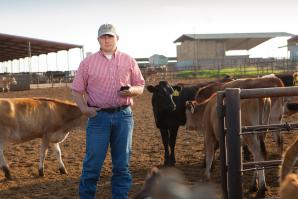As economic indicators go, Thanksgiving turkey sales are often a good one.
In 2009, 250 million turkeys were raised nationally, an 8 percent decrease from 2008 when turkey production totaled $4.5 billion (and a whopping 7.9 billion pounds), according to the U.S. National Agricultural Statistics Service. In California, the sixth-largest turkey producer in the country after Minnesota, Arkansas, Missouri, North Carolina and Virginia, that added up to about $220 million.
Turkey prices fluctuate based on the season, says IBISWorld industry analyst Dmitry Kopylovsky. “As you might expect, the price shoots up around September/October/November and falls back down in late December and into January.” Fourth quarter sales alone account for as much as 40 percent of annual turkey revenue.
Corti Brothers gourmet grocery owner Darrell Corti sells about 1,000 turkeys a year between Thanksgiving and Christmas but says turkey meat is becoming more common in items sold year-round.
Corti sells both his own brand of turkey and a smaller-breasted, more expensive heritage turkey. “Genetics is one thing, how they are treated is another; they have to be left out to flock together,” Corti says. “California is ideal for raising turkeys with plenty of room to grow and fairly mild temperatures.”
While the best-selling bird brand for the past 40 years has been the North Carolina-based Butterball, family-owned boutique brands such as Woodland-based Branigan’s, â?¨Sonora-based Diestel and Fresno-based Mary’s Turkey, are gaining traction locally. The free-range specialty turkeys run $1 to $5 more per pound, but enthusiasts swear they taste better.
The Branigan family has been raising turkeys at its eponymous Yolo County farm since 1942. They raise about 20,000 turkeys a year to sell at Nugget Markets and Cracchiolo’s Market Deli Catering & Banquet Facility, where customers start reserving their dinner staple as far as a year in advance.
Mary Pitman, owner of Mary’s Free Range Turkey, a farming and processing operation that also dates back to the 1940s, says business is brisk despite the economy. Each year, her family raises about 100,000 poults — free range, organic and heritage varieties — a process that takes six to seven months compared to two months for the modern, double-breasted varieties. Even in those quantities, her brood is completely committed to stores by September.
“I had a woman call to tell me she lost her job, but she was still going to have a heritage turkey because it was that important,” Pitman says. She credits humane treatment, a stress-free environment and cleaner living quarters for producing a healthier and happier turkey, which in turn, she says, results in a better tasting Thanksgiving dinner.
The Diestel Family Turkey Ranch has been raising range-grown turkeys since 1949. They use a diet of low-fat, growth-hormone-free feed made of corn and soybeans. These sustainably farmed birds are sold in Raley’s and Bel Air stores in the Sacramento area. They come in organic, petite and heirloom varieties.
Unlike modern white turkeys bred with breasts so large and legs so short they can’t naturally reproduce, colorful heirloom or heritage turkeys grow slower. Some growers even promote that they don’t clip the birds’ wings, toenails or beaks and let them roam free, so they are as close to a wild bird as possible. Many believe the resulting meat is more flavorful than mass-produced commodity birds and are willing to pay the extra cost involved in raising them.
Heritage breeds make up about 5 percent of the turkeys sold each year. Along with organic turkeys, they are the fastest-growing segment of the market, according to the American Livestock Breeds Conservancy. “Consumers want and are willing to pay for the environmental assurance as well as great taste they get with certified organic poultry,” says Katherine DiMatteo of the Organic Trade Association.
As the market changes, growers are looking for new ways to meet the demand, either by breeding different birds or getting them to the table faster.
Recommended For You

Reap, Sow, Tweet
Branding ag through social media
“Good morning, Sacramento! It’s a perfect day for a pig roast. Come out and join us,” hog farmer Perrin Clark tweeted on a long-awaited day in May.

The Green Flash
There's energy in Solano's technology sector
An influx of green manufacturing companies and a burgeoning renewable-energy sector is creating the critical mass Solano County needs to usher in a new era of competitive economic growth.


